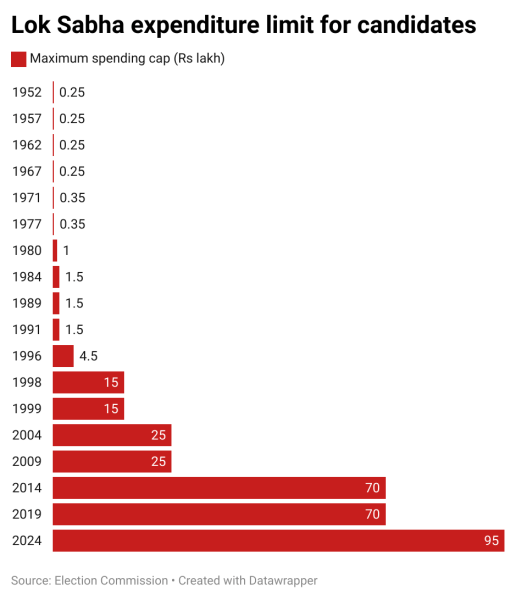With the general elections underway, among the Election Commission’s (EC) key responsibilities is monitoring poll expenditure, both by parties and individual candidates, through its own observers and state and Central enforcement agencies. While there is no cap on how much parties can spend, candidates are limited to Rs 95 lakh for Lok Sabha constituencies and Rs 40 lakh for Assembly seats. In some smaller states and Union Territories, the cap is Rs 75 lakh and Rs 28 lakh for the Lok Sabha and Assemblies, respectively.
The spending limits have been increased over the years, including from 2019, when these were Rs 70 lakh for Lok Sabha candidates and Rs 28 lakh for Assembly contenders.
The expenditure limit refers to the amount a candidate is allowed to legally spend on election campaigning, including public meetings, rallies, advertisements, posters and banners, and vehicles. All candidates are required to submit their expenditure statement to the EC within 30 days of completion of an election.
The EC frequently revises the spending limit, largely based on cost factors and the increasing number of voters. In 2022, the last time the cap was revised, the EC had formed a committee and invited suggestions from political parties, chief electoral officers and election observers, and found that there had been a substantial increase in the number of electors and Cost Inflation Index since 2014. The Cost Inflation Index (CFI) — used to estimate the increase in prices of goods and assets year-on-year due to inflation – has gone up from ‘240’ in 2014-15 to ‘317’ in 2021-22.
In the first general election in 1951-52, Lok Sabha candidates were allowed to spend a maximum of Rs 25,000, and just Rs 10,000 in some Northeastern states. The limits weren’t changed until 1971, when the spending cap was raised to Rs 35,000 for most states. In 1980, the cap was again raised, this time by a considerable sum, to Rs 1 lakh per candidate. In 1984, it was raised to Rs 1.5 lakh in some states and Rs 1.3 lakh in some smaller states. For states with one to two Lok Sabha seats, the cap went only as high as Rs 1 lakh, with some UTs like Chandigarh restricted to just Rs 50,000.
CHART: Spending cap for Lok Sabha candidates
 Spending cap for Lok Sabha candidates (Chart by Anjishnu Das)
Spending cap for Lok Sabha candidates (Chart by Anjishnu Das)
The next change came in 1996, the post-liberalisation election, when the limit for most states was raised three-fold to Rs 4.5 lakh, with variations depending on UT status and number of seats. In the very next election, in 1998, the spending cap was raised by even more, to Rs 15 lakh. In 2004, it was again raised to Rs 25 lakh. The limit went unchanged over the next decade, until 2014, when it was more than doubled to Rs 70 lakh. In 2022, after the 2019 polls, the spending cap was raised to the current figures.
At the district level, state ECs publish rate lists of a range of items for election expenditure, from accommodations, transport and hoardings for candidates to tenting, garlands, flags and food for rallies, with variations depending on the size and material of the item. While most districts are yet to publish the rate lists on their websites, in Madhya Pradesh’s Jabalpur, for instance, there are limits on even basic stationery items like pens and scissors. Officials even put out detailed rate lists for food – in the Jabalpur district, tea or coffee and biscuits cannot cost more than Rs 7 per serving while thali meals can only go up to Rs 97.
Parties are also spending increasing sums on their candidates. In 2019, of the total Rs 2,994 crore officially spent by 32 national and state parties during the polls, Rs 529 crore went to candidates as a lumpsum. In 2014, an analysis by the Association for Democratic Reforms found that 342 winning candidates from five national parties together received Rs 75.6 crore, as per the MPs’ own declarations. In 2009, 388 MPs from six national parties reported receiving a total Rs 14.2 crore.
Political parties are required to submit detailed election expenditure reports to the EC within 90 days of completion of Lok Sabha elections.